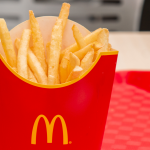How Haribo Sweets is mastering the data-led supply chain

The maker of jelly babies, gummy bears, and licorice allsorts— Haribo’s global success is a testament to its slogan, ‘Haribo makes children happy— and adults as well.’
But the iconic sweet brand’s success doesn’t just come down to its product; Haribo takes a data-led approach, ensuring its supply chain is optimized to meet supply and demand with maximum efficiency, all year round.
Founded in 1920, the European sweet manufacturer never stands still, adopting the latest technology to ensure its products are always flying off the shelves, even as the competition and market get ever more crowded.
Keeping up with the demand for its much-loved products and ongoing global expansion efforts means the business must constantly work to ensure efficiency on every rung of its supply chain. Globally, that includes 19 production sites and 10 distribution centers— it employs around 6,000 people and exports to more than one hundred countries.
According to research by Kantar, more than half of consumers purchase sweets on an impulse, while every household purchases an average of 3.6kg of sweets per year. This, said Elsa Cros, a demand planning specialist at Haribo France, makes stocking a wide variety of flavors and launching new lines and promotions vital for seizing market share, particularly amidst seasonal peaks such as Halloween.
But this is a strategy Haribo is seasoned at. Out of the top twenty best-sellers in the sugar confectionery market the last year in France, Haribo could claim eleven.
The company has over 800 varieties in its line, and manufacturers more than 50,000 tons of produce each year in France; forecasting the quantities of each variety as accurately as possible is crucial to maximizing profit margins.
“Taste and preferences vary from country to country and region by region, so we have to adapt to each accordingly,” said Cros. “For instance, Italians are very fond of licorice, so the product mix needs to reflect this.”
Before the company implemented demand and promotion planning software in 2017, managing supply and demand relied on manual data entry, which was “extremely laborious”.
The tools it has in place now— one being a supply-chain planning system called FuturMaster— can allow the company to forecast production and promotional plans up to a year in advance.
The software also allows Haribo to schedule production and ensure the right ingredients and packaging materials are available when and where required. This helps orchestrate some 3,700 trucks running between its facilities in Europe.
Since bringing the forecasting technology into its supply-chain infrastructure, Haribo says its forecast accuracy has risen from 60 percent to 80 percent, while service levels approached 99 percent in 2018.
As a result, the last year or so has seen slow-moving stock and product obsolescence cut by three.
YOU MIGHT LIKE

Now even whiskey is being made with AI
The effect isn’t just felt on the production lines, though. The confectionery firm has turned around what has been 3.1 percent average sales drops, according to Neilsen, to increase 1.7 percent at the tale-end of 2018. In France, Haribo now controls a staggering 39 percent of the entire sweets category.
Haribo expects to continue enhancing the efficiency of its stock forecasting and supply chain as developments in artificial intelligence ramp up the possibilities of predictive software.
This could limit the risk of stock selling out, and allow for more reactive product launches and promotions.









